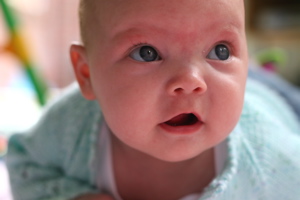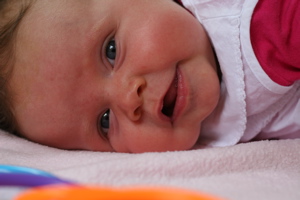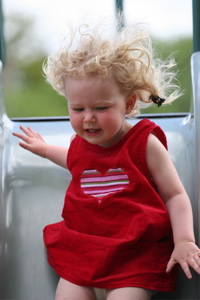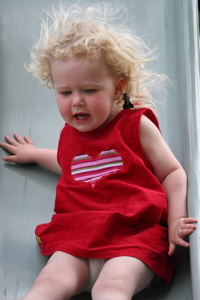Today I took the Photo Friday winners to Tumwater Falls Park. I taught them how shutter speed affects the look of pictures that have moving objects. Water is an easy way to see this. When the water looks smooey, we say that the shutter was opened longer (maybe 1/4, 1/20 sec). If the water looks like little diamonds then the shutter was fast (1/250, 1/1000 sec.).
Thursday, June 30, 2011
Tuesday, June 28, 2011
Tips for Better Pictures of Children
 I thoroughly enjoy photographing children and have opportunity to do quite a bit of it lately after many of our friends have had babies.
I thoroughly enjoy photographing children and have opportunity to do quite a bit of it lately after many of our friends have had babies.Probably the most important tip I’ve learned in photographing them is to get on their level. So many of my friends show me photos of their kids which are taken from 4 or so feet above the child which does nothing but dwarf them and make them look almost toy-like.
Getting on your hands and knees or crouching down before you take a shot of a child takes you into their world and helps you to engage with them through the images you take.
 Photographing Babies
Photographing BabiesBabies are particularly difficult to photograph because they are so immobile. I find that one of the best ways to get good shots of them is to put them on a baby rug and too literally lie down next to them with your camera right on the floor. In this way you’re looking directly into their big beautiful eyes and it puts the viewer of the photo in the unique perspective of an eye to eye place. If the child has the ability to lift it’s head the effects can be amazing as you almost find yourself looking UP into their eyes.
Photographing Older Children
The same principle of getting down low applies with older children although you do have a little less lying on the floor with them when they are at an age of walking.
I particularly find that with older children the best time to photograph them is when they are doing something that they enjoy. Go to the park with them and their parents, visit their house when they are painting pictures, get them to take you on a tour of their room or take them out to play their favorite sport.
While they are doing their activity hover around (at their level) and take plenty of shots. Also include shots with them and their parents and keep an eye open for those candid moments when they fall over, do funny expressions or ham it up for the camera.
If your camera has a continuous shooting mode it might also be worth keeping that on with bigger kids who tend to move around more. As I look back at the times I’ve done this it’s quite interesting to see that it’s often the second or third shot in a sequence that is best. Shooting just one frame at a time can mean you miss these golden opportunities.
Another benefit of continuous shooting is that you can end up with a great series of shots that might go nicely together to tell a story (see below).



Read more: http://www.digital-photography-school.com/photographing-children-composition#ixzz1Qdd2zphn
Monday, June 27, 2011
Skewer Through Balloon
How can you pierce a balloon and not make it pop?!?
 |
| Balloons are made of a thin sheet of a rubber called latex, a polymer made of long chain-like molecules, or strands, that are all tangled together. |
 |
| There are also bonds between the strands, call cross-links. This tangled, cross-linked network of molecules can be stretched, but when you let go, it returns to its original shape. |
 |
| This happens when the skewer is twisted through the side of the balloon. |
 |
| Make sure to poke through where the latex molecules are under the least amount of pressure. Near the tied part of the balloon. |
 |
| When a very sharp skewer is slowly pushed, with twisting, into the balloon, the polymer chains are pushed aside, but remain bonded, so the balloon does not break. |
 |
| The Vaseline helps to seal the holes. |
Saturday, June 25, 2011
Check this Out
This morning, I went blog searching for schools of photography. No sooner do I click on the first one then, BAM! This pops up: 8 Great Tips for Photographing Bees. I has some good tips not limited to photographing bees.
Friday, June 24, 2011
A Well Taken Late Entry
This afternoon I received this picture. I thought it needed to be shared with you all.
Next week's photo theme: Children's faces
Look for expressions that show emotion.
 |
| Think of taking one like this as children slide down the water slide. |
Photo Friday: Bees
Good job to the Photo Friday winners!
Excellent pictures; I love the skill with which you were able to focus on the bee. The colors are beautiful.
Excellent pictures; I love the skill with which you were able to focus on the bee. The colors are beautiful.
 |
| 1st place winner, Tim Michaelis. |
 |
| 2nd place winner, AnnMarie. |
 |
The winners have qualified to have a special photography class with me next week.
Tuesday, June 21, 2011
Color Changing Milk: An Explosion of Color
Some very unusual things happen when you mix a little
milk, food coloring, and a drop of liquid soap.
milk, food coloring, and a drop of liquid soap.
 |
| The materials for this week's science experiment: milk, soap (in the cup) and food coloring. |
 |
| Have fun. Try all different colors and sizes of drops. |
 |
| The secret of the bursting colors is the chemistry of that tiny drop of soap. |
 |
| Dish soap weakens the chemical bonds that hold the proteins and fats in the milk. |
 |
| The molecules of fat bend, roll, twist, and contort in all directions as the soap molecules race around to join up with the fat molecules. |
 |
| During all of this fat molecule gymnastics, the food coloring molecules are bumped and shoved everywhere, providing an easy way to observe all the invisible activity. |
 |
| As the soap becomes evenly mixed with the milk, the action slows down and eventually stops. |
Monday, June 20, 2011
Photo Friday Theme
Friday, June 17, 2011
Photo Friday
Wow! Such creative pictures were emailed in this week. I love the "taste" of summer that is shown in the pictures. Good job! These are the three winners.
 |
| S'more by Timmy Michaelis |
 |
| Annie |
 |
| Finally, A Sign of Summer by Emily Hier |
Wednesday, June 15, 2011
How Much Fun Can A Simple Science Experiment Be?
Science is fun. No doubt about that. There are experiments all over and I plan on exploring these interesting activities throughout the summer.
Today's materials list: diet coke & mentos
When my brothers saw the reaction of the soda when mixed with mentos, they decided to join in the fun.
Remember to email your pictures for this week's Photo Friday!
Theme: Summer (or not?)
Today's materials list: diet coke & mentos
 |
| Such simple materials. Yet sooooo fun! |
 |
| Ruby began with putting as many mentos in the soda as she could. |
 |
| Only 1 mento made it in! |
When my brothers saw the reaction of the soda when mixed with mentos, they decided to join in the fun.
Why do Mentos mixed with soda produce this incredible eruption?
When you drop the Mentos into the soda, the gelatin and gum arabic from the dissolving candy break the surface tension. This disrupts the water mesh, so that it takes less work to expand and form new bubbles. Each Mentos candy has thousands of tiny pits all over the surface. These tiny pits are called nucleation sites - perfect places for carbon dioxide bubbles to form. As soon as the Mentos hit the soda, bubbles form all over the surface of the candy. When all this gas is released, it literally pushes all of the liquid up and out of the bottle in an incredible soda blast.
Watch the experts.
Subscribe to:
Posts (Atom)

























